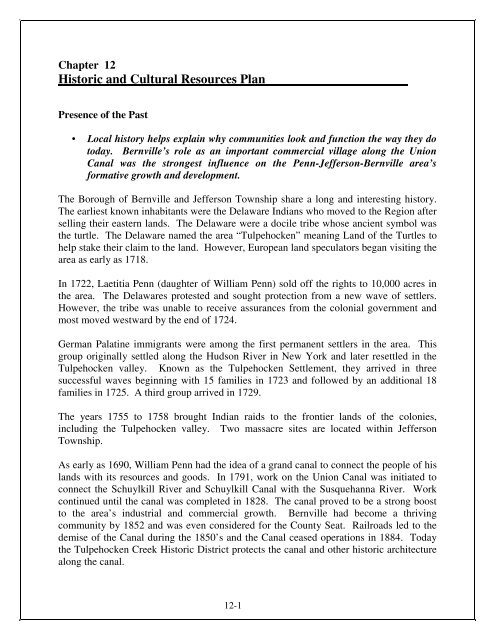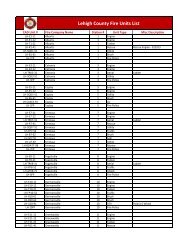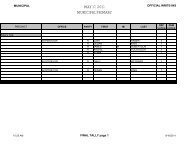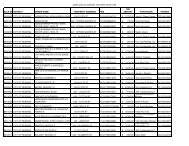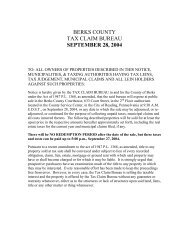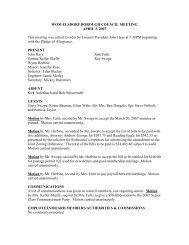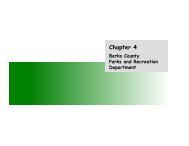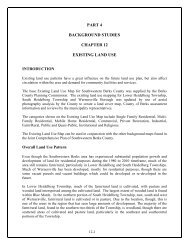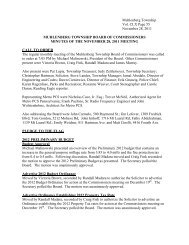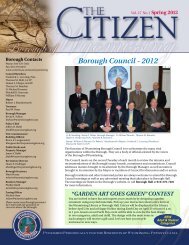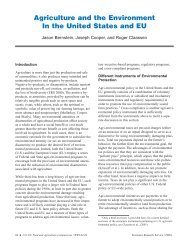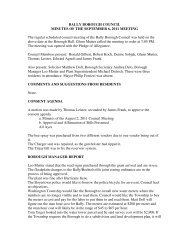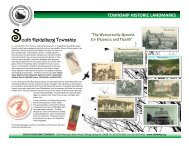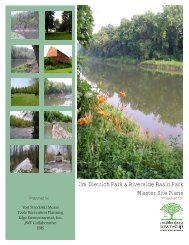Historic and Cultural Resources Plan - Berks County
Historic and Cultural Resources Plan - Berks County
Historic and Cultural Resources Plan - Berks County
Create successful ePaper yourself
Turn your PDF publications into a flip-book with our unique Google optimized e-Paper software.
Chapter 12<br />
<strong>Historic</strong> <strong>and</strong> <strong>Cultural</strong> <strong>Resources</strong> <strong>Plan</strong><br />
Presence of the Past<br />
• Local history helps explain why communities look <strong>and</strong> function the way they do<br />
today. Bernville’s role as an important commercial village along the Union<br />
Canal was the strongest influence on the Penn-Jefferson-Bernville area’s<br />
formative growth <strong>and</strong> development.<br />
The Borough of Bernville <strong>and</strong> Jefferson Township share a long <strong>and</strong> interesting history.<br />
The earliest known inhabitants were the Delaware Indians who moved to the Region after<br />
selling their eastern l<strong>and</strong>s. The Delaware were a docile tribe whose ancient symbol was<br />
the turtle. The Delaware named the area “Tulpehocken” meaning L<strong>and</strong> of the Turtles to<br />
help stake their claim to the l<strong>and</strong>. However, European l<strong>and</strong> speculators began visiting the<br />
area as early as 1718.<br />
In 1722, Laetitia Penn (daughter of William Penn) sold off the rights to 10,000 acres in<br />
the area. The Delawares protested <strong>and</strong> sought protection from a new wave of settlers.<br />
However, the tribe was unable to receive assurances from the colonial government <strong>and</strong><br />
most moved westward by the end of 1724.<br />
German Palatine immigrants were among the first permanent settlers in the area. This<br />
group originally settled along the Hudson River in New York <strong>and</strong> later resettled in the<br />
Tulpehocken valley. Known as the Tulpehocken Settlement, they arrived in three<br />
successful waves beginning with 15 families in 1723 <strong>and</strong> followed by an additional 18<br />
families in 1725. A third group arrived in 1729.<br />
The years 1755 to 1758 brought Indian raids to the frontier l<strong>and</strong>s of the colonies,<br />
including the Tulpehocken valley. Two massacre sites are located within Jefferson<br />
Township.<br />
As early as 1690, William Penn had the idea of a gr<strong>and</strong> canal to connect the people of his<br />
l<strong>and</strong>s with its resources <strong>and</strong> goods. In 1791, work on the Union Canal was initiated to<br />
connect the Schuylkill River <strong>and</strong> Schuylkill Canal with the Susquehanna River. Work<br />
continued until the canal was completed in 1828. The canal proved to be a strong boost<br />
to the area’s industrial <strong>and</strong> commercial growth. Bernville had become a thriving<br />
community by 1852 <strong>and</strong> was even considered for the <strong>County</strong> Seat. Railroads led to the<br />
demise of the Canal during the 1850’s <strong>and</strong> the Canal ceased operations in 1884. Today<br />
the Tulpehocken Creek <strong>Historic</strong> District protects the canal <strong>and</strong> other historic architecture<br />
along the canal.<br />
12-1
Both Bernville <strong>and</strong> Jefferson Township were originally part of Tulpehocken Township.<br />
Stephanus Umbenhauer founded Bernville in 1819 <strong>and</strong> named it after Bern, Switzerl<strong>and</strong>.<br />
Bernville <strong>and</strong> Jefferson Township were each incorporated separately in 1851. Joseph<br />
Conrad, a local mill owner <strong>and</strong> Bernville resident, served in the state legislature during<br />
the 1870’s. His 1840’s circa home can still be found along Main Street in the Borough.<br />
Penn Township was first settled by German farmers in the late 1700s. It was originally<br />
part of Bern Township, then Upper Bern Township. The village of Mt. Pleasant was first<br />
settled in 1812 <strong>and</strong> consisted of residences, several factories, an inn <strong>and</strong> a tavern. In<br />
1828, the Union Canal was completed, connecting the Susquehanna <strong>and</strong> Schuylkill<br />
Rivers. The Bernville Locks became one of the main ports along the Canal, <strong>and</strong> a<br />
community developed around this port.<br />
In 1838, residents of the area petitioned the <strong>Berks</strong> <strong>County</strong> Court of Quarter Sessions to<br />
create a new township from parts of Bern, Heidelberg, Upper Bern, <strong>and</strong> Upper<br />
Tulpehocken Townships. These existing townships were seen as too large to be<br />
conveniently accessible to residents of this area or to be effective in keeping roads in<br />
good repair. In May of that year, the Court rejected the petition, but in November 1840,<br />
the Court approved a second petition, thus erecting a new township from parts of Bern<br />
<strong>and</strong> Upper Bern Township <strong>and</strong> including an area that is now Penn Township <strong>and</strong><br />
Bernville Borough.<br />
The recommended name for the new Township was “Northkill”, but the Court suggested<br />
“Penn”, in honor of the founder of Pennsylvania, <strong>and</strong> on November 5, 1841, Penn<br />
Township was created. In 1851, the village of Bernville, discontented with the<br />
Township’s inability to properly maintain roads <strong>and</strong> provide adequate community<br />
services, was incorporated as a borough. The village of Mt. Pleasant then became Penn<br />
Township’s largest settlement. The Township continued to prosper because of the Canal<br />
until after the Civil War. Railroads began to replace waterways as the primary means of<br />
transporting goods, <strong>and</strong> in 1884, the Canal ceased operation. As the result of the<br />
ab<strong>and</strong>onment of the Canal <strong>and</strong> railroads bypassing the Township, Penn Township’s<br />
economy faltered, with factories closing <strong>and</strong> its population decreasing. This decline<br />
lasted into the early 1900s.<br />
With the introduction of the automobile, Penn Township experienced a new vitality, <strong>and</strong><br />
by 1930, the automobile was the major influence in the Township’s growth <strong>and</strong><br />
development. The Township was the location of hundreds of summer bungalows, with a<br />
large colony of them situated along the Tulpehocken Creek between Mt. Pleasant <strong>and</strong><br />
Bernville. The Mt. Pleasant Fire Company was formed in 1921, with a charter granted in<br />
1924. In 1931, the Penn-Bernville Consolidated School was dedicated. The post-war<br />
boom <strong>and</strong> migration from urban areas in the 1950s brought additional persons into the<br />
Township. Between 1960 <strong>and</strong> 1980, Penn Township experienced a dramatic change in<br />
its l<strong>and</strong> use composition. The projects which were directly responsible for this change<br />
12-2
were the development of the Blue Marsh Project <strong>and</strong> the expansion of the Pennsylvania<br />
State Game L<strong>and</strong>s. Approximately 3,220 acres or 26.1 percent of the l<strong>and</strong> area within<br />
Penn Township is consumed by the Blue Marsh Project <strong>and</strong> Pennsylvania State Game<br />
L<strong>and</strong>s.<br />
The development <strong>and</strong> construction of the Blue Marsh Project was authorized as part of<br />
the Flood Control Act of 1962 (Public Law 87-874). Blue Marsh Lake is located along<br />
the Tulpehocken Creek in the Delaware River Basin, six (6) miles northwest of the City<br />
of Reading. A significant portion of the Blue Marsh Project is located within the<br />
southern part of Penn Township. Construction of the Blue Marsh Dam <strong>and</strong> Reservoir<br />
commenced in March of 1974 <strong>and</strong> concluded in September of 1979. The Blue Marsh<br />
Project was designed as a multi-purpose project for flood control, water supply, low flow<br />
augmentation, recreation <strong>and</strong> water quality control. The reservoir is designed to contain<br />
up to 11 billion gallons of flood water above the normal winter pool, providing flood<br />
protection for events up to <strong>and</strong> including the 100-year flood. Approximately 540 acres or<br />
4.4 percent of the l<strong>and</strong> area within Penn Township is consumed by the Blue Marsh<br />
Project.<br />
Through the development of the Blue Marsh Project, the Pennsylvania State Game L<strong>and</strong>s<br />
were exp<strong>and</strong>ed to serve as a natural <strong>and</strong> physical buffer to the Blue Marsh Lake. The<br />
Pennsylvania State Game L<strong>and</strong>s were exp<strong>and</strong>ed in Penn Township through separate acts<br />
of either acquisition or condemnation by the Commonwealth of Pennsylvania.<br />
Approximately 2,280 acres or 21.7 percent of the l<strong>and</strong> area within Penn Township is<br />
consumed by the Pennsylvania State Game L<strong>and</strong>s.<br />
Between 1980 <strong>and</strong> 1990, Penn Township had the greatest percentage increase in<br />
population among all municipalities within <strong>Berks</strong> <strong>County</strong>. This growth rate was the<br />
result of a number of factors, including a desirable location, improvements to the<br />
transportation network, development pressures, the availability of reasonably priced l<strong>and</strong>,<br />
<strong>and</strong> the expansion of public utilities.<br />
12-3
Table 12.1: <strong>Historic</strong> Sites Borough of Bernville<br />
Map ID Feature Name<br />
1 Filberts Tavern & Union House<br />
2 Arthur Harms Property<br />
3 Barr Property<br />
4 Mildred Balthaser Property<br />
5 Edith Kirkhoff Property<br />
6 Alan Speicher Property<br />
7 Marvin Luckenbill Property<br />
8 Stanley Klopp Property<br />
9 Frank Speaker Property<br />
10 Stanley Klopp Property<br />
11 Stanley Klopp Property<br />
12 Walter Krause Property<br />
13 Lester Lesher Property<br />
14 Paul Sheetz Property<br />
15 Walter Berger Property<br />
16 Clarence Reber Property<br />
17 Brights Store<br />
18 Margaret Burkey Property<br />
19 Lutheran Parsonage<br />
20 St Thomas Church<br />
21 Umbenhauer Homestead<br />
22 Bernville Borough<br />
23 Penn Township School<br />
24 Runkle Inn<br />
25 White Horse Hotel<br />
26 Joseph B. Conrad Home<br />
27 Frieden's Church<br />
28 Burkhart Tin Smith Shop<br />
29 1st National Bank<br />
30 Shock's Store<br />
31 Blatt's Photo Gallery<br />
32 Bernville Bakery<br />
33 Northkill Church <strong>and</strong> Cemetery<br />
34 American House Hotel<br />
35 Bennethum Tannery hide house<br />
36 Mennonite Church<br />
37 First Fire Hall<br />
38 Umbenhauer Park Sign<br />
39 Greering Home<br />
Source: <strong>Berks</strong> <strong>County</strong> <strong>Plan</strong>ning Department<br />
12-4
Table 12.2: <strong>Historic</strong> Sites Penn <strong>and</strong> Jefferson Townships<br />
MAP ID Feature Name MAP ID Feature Name<br />
1 N/A - log structure 45 N/A - brick structure<br />
2 Tannery Monument 46 New Schaefferstown<br />
3 Adam Potteiger Homestead 47 New schaefferstown School<br />
4 Batdorf Farm 48 Peter Fox Homestead<br />
5 Beaver Tree Farm 49 Potteiger Farm<br />
6 Christ Church Farmhouse 50 Samuel Miller Farm<br />
7 Christ Little Tulpehocken Church 51 Schaeffer Homestead<br />
8 Christmas Village 52 Scharff Farm<br />
9 Cross Keys Inn 53 St Paul's Evangelical Lutheran<br />
10 Daniel Wagner Homestead 54 Staley Property<br />
11 Derr House 55 Stupp Homestead<br />
12 Derr House 56 Tulpehocken Hotel<br />
13 Ditzler Homestead 57 Tulpehocken Lodge Hall<br />
14 Dundore 58 Union Canal Lock 29<br />
15 E. Schaeffer House 59 Union Canal Lock 30<br />
16 Fox Shoe Shop 60 Union Canal Lock 31<br />
17 Groff House 61 Union Canal Lock 32<br />
18 Groff Road School House 62 Union Canal Lock 33<br />
19 Gruber Homestead 63 Union Canal Lock 34<br />
20 Haag Gristmill 64 Union Canal Lock 35<br />
21 Harry Derr House Property 65 Union Canal Lockhouse<br />
22 Henne School 66 Wagners's School "Lash"<br />
23 Hilltop or Weaver's School 67 Wilhelm Homestead<br />
24 Holtzman Property 68 William Reed Homestead<br />
25 J.A. Wagner House 69 Yeakley-Schaeffer-Strause<br />
26 Jacob Gerhart Mill 70 Yost Mill<br />
27 Jeremiah Weaver Farm 71 Yost School<br />
28 John Nicholas & Elizabeth Moyer 72 Zerbe Property<br />
29 Joseph Derr Farm 73 Bright Homestead<br />
30 Kissling Farm 74 Bright School<br />
31 Klee Tilt-hammer 75 David Bond House<br />
32 Klein Family Cemetery 76 Davis School<br />
33 Klein Homestead 77 Fisher Grist Mill<br />
34 Kline Farm 78 George Jacob Haak<br />
35 Knoll Blacksmith Shop 79 George Kauffman House<br />
36 Lash Homestead 80 Haag Grist Mill<br />
37 Lengel House 81 Hass Tavern<br />
38 Leshers Store 82 Heister Farm<br />
39 Liese Farm 83 Kalbach Farms<br />
40 Liese Homestead 84 Kissling Farm<br />
41 Michael Fox House 85 Kline Sawmill<br />
42 Miles Schock Homestead 86 Obold Mount Pleasant<br />
43 Mogel's School House 87 Obold Store<br />
44 Moyer Farm 88 Scull Hill Post Office<br />
Source: <strong>Berks</strong> <strong>County</strong> <strong>Plan</strong>ning Department<br />
12-5
HISTORIC AND CULTURAL RESOURCES PLAN<br />
The Region’s history is reflected in its architecture, people, <strong>and</strong> character. <strong>Historic</strong><br />
resources connect us to the past, emphasize our sense of community, <strong>and</strong> often provide<br />
aesthetic value. In addition, historic resources can provide tourism benefits which often<br />
lead to economic development opportunities. <strong>Plan</strong>ning for the protection of historic<br />
resources is especially important because historical resources are not renewable.<br />
Many of the buildings found along the Region’s highways, country roads, <strong>and</strong> village<br />
streets are examples of vernacular architecture. Although they may feature some of the<br />
elements commonly found in a particular style, mainly Germanic, vernacular architecture<br />
incorporates an individual builder's ideas into an overall design. The mixture of the<br />
vernacular <strong>and</strong> German examples enhances the overall character of the Region.<br />
<strong>Historic</strong> Districts<br />
Local historic districts are areas in which historic buildings <strong>and</strong> their settings are<br />
protected by public review. <strong>Historic</strong> district ordinances are local laws adopted by<br />
communities using powers granted by the state. <strong>Historic</strong> districts consist of the Region's<br />
significant historic <strong>and</strong> architectural resources. Inclusion in a historic district signifies<br />
that a property contributes to a group of structures that is worth protecting because of its<br />
historic importance or architectural quality.<br />
Potential areas where official ‘<strong>Historic</strong> District’ status can be pursued in the Region<br />
include the following:<br />
- Main Street in Bernville;<br />
- Portions of the Village of New Schaefferstown<br />
National Register of <strong>Historic</strong> Places<br />
The National Register of <strong>Historic</strong> Places is the nation's official list of cultural resources<br />
worthy of preservation. Authorized under the National <strong>Historic</strong> Preservation Act of 1966,<br />
the National Register is part of a national program to coordinate <strong>and</strong> support public <strong>and</strong><br />
private efforts to identify, evaluate, <strong>and</strong> protect our historic <strong>and</strong> archeological resources.<br />
Properties listed in the Register include districts, sites, buildings, structures, <strong>and</strong> objects<br />
that are significant in American history, architecture, archeology, engineering <strong>and</strong><br />
culture.<br />
Currently, there is only one site in the Region that is listed on the National Register – the<br />
John Nicolas <strong>and</strong> Elizabeth Moyer House, located in Jefferson Township. There are<br />
many other historic sites (see Tables 12.1 & 12.2) that while not on the National Register,<br />
are significant on a local scale, <strong>and</strong> add to the distinct character <strong>and</strong> cultural heritage of<br />
the Region.<br />
12-6
<strong>Cultural</strong> <strong>Resources</strong><br />
<strong>Cultural</strong> resources are the special characteristics that make a community unique. A<br />
community that takes pride in <strong>and</strong> respects its traditions is typically a community with a<br />
well-defined character. The Region contains a rich, diverse heritage with significant<br />
cultural resources that should be embraced <strong>and</strong> preserved. Much of the rich culture in<br />
the Region is derived from the influences of the early German settlers who arrived in the<br />
Townships in the mid 1700s. Many examples of the architecture <strong>and</strong> customs of these<br />
people still remain, reflected in the historic farmhouses, churches, grist mills, <strong>and</strong> canal<br />
locks that enhance the Region’s heritage.<br />
<strong>Historic</strong>, Architectural <strong>and</strong> <strong>Cultural</strong> <strong>Resources</strong><br />
Goal: Protect, preserve, <strong>and</strong> enhance the remaining historic, architectural, <strong>and</strong><br />
cultural resources <strong>and</strong> their surroundings.<br />
Objectives:<br />
• Discourage inappropriate development in historic areas of the Region,<br />
require impact studies for development near historic resources, <strong>and</strong> require<br />
mitigation of any potential adverse impacts on historic resources.<br />
• Maintain <strong>and</strong> initiate partnerships with the <strong>Berks</strong> <strong>County</strong> Conservancy <strong>and</strong><br />
other organizations to protect the Region’s built treasures.<br />
• Provide for adaptive re-use of historic structures where appropriate.<br />
• Encourage the identification, marking, <strong>and</strong> interpretation of historic<br />
resources in the Region, <strong>and</strong> foster increased public awareness of the<br />
history of the Region.<br />
• Determine the role which the municipalities should play in historic<br />
preservation through l<strong>and</strong> use ordinance incentives <strong>and</strong> regulations <strong>and</strong><br />
efforts to create historic overlay zoning.<br />
• Require new development to consider the history, architecture <strong>and</strong><br />
development patterns of the municipalities in order to preserve the<br />
important historic <strong>and</strong> architectural resources of the Region.<br />
• Discourage demolition by neglect <strong>and</strong> deterioration of historic resources.<br />
12-7
• Identify existing contemporary sites which could be considered part of the<br />
historical or cultural heritage of future generations <strong>and</strong> work to preserve<br />
these sites for future generations.<br />
• Support cultural events which celebrate the historic <strong>and</strong> cultural heritage of<br />
the Region.<br />
• Consider historic overlay zoning which provides special protection for<br />
historic sites including farm houses, barns, mills, old schoolhouses, <strong>and</strong><br />
churches.<br />
• Maintain the regional survey of historic resources contained within the<br />
<strong>Berks</strong> <strong>County</strong> Greenway, Park <strong>and</strong> Recreation <strong>Plan</strong>..<br />
<strong>Historic</strong> <strong>and</strong> <strong>Cultural</strong> Resource Actions:<br />
A. Update zoning ordinances as necessary to protect historic resources <strong>and</strong><br />
community character. Options include:<br />
1. Adopt <strong>Historic</strong> Resource Overlay Zoning. Concentrate on the <strong>Historic</strong><br />
Overlay District, as depicted on the Future L<strong>and</strong> Use Map.<br />
a. Create historical commissions <strong>and</strong> / or committees where they do not<br />
exist or a joint historical commission<br />
b. Identify historic resources<br />
c. Require developers to analyze:<br />
• Nature of historic resources on <strong>and</strong> near property<br />
• Impact of proposals on historic resources, <strong>and</strong><br />
• Mitigation measures<br />
d. Encourage adaptive reuse of historic buildings<br />
e. Establish use, coverage, density, intensity, <strong>and</strong> yard bonuses for<br />
architectural treatments, building design, amenities, <strong>and</strong> open<br />
spaces/buffers compatible with existing resources, appropriate reuse<br />
of existing resources <strong>and</strong> donation of façade easements<br />
f. Encourage architecture, materials, <strong>and</strong> development patterns<br />
characteristic to the area<br />
12-8
2. Adopt Demolition by Neglect Provisions:<br />
a. Require property owners to protect <strong>and</strong> maintain historic properties<br />
to avoid demolition by v<strong>and</strong>alism or the elements by requiring<br />
unoccupied structures to be sealed or secured by fencing<br />
3. Identify provisions to protect the character of villages, <strong>and</strong> have streets,<br />
buildings, <strong>and</strong> public spaces integrated to create a sense of place with<br />
pedestrian scale. Consideration can be given to adopting the following as<br />
st<strong>and</strong>ards or promoting them through incentives:<br />
a. Allow only appropriate uses in scale with, <strong>and</strong> compatible with,<br />
existing appropriate uses, discouraging uses that would transform the<br />
character of the areas.<br />
b. Establish coverage, density, intensity, <strong>and</strong> yard bonuses for<br />
architectural treatments, building design, amenities, street furniture,<br />
open spaces, <strong>and</strong> parking designs consistent with the character of the<br />
area.<br />
c. Require pedestrian amenities as necessary improvements to be made<br />
by l<strong>and</strong> developers.<br />
d. Construct parking areas to the rear <strong>and</strong> side of buildings <strong>and</strong><br />
establish st<strong>and</strong>ards for design, buffering, <strong>and</strong> l<strong>and</strong>scaping of new<br />
parking facilities.<br />
e. Require signage appropriate to the area.<br />
f. Establish appropriate st<strong>and</strong>ards for driveway design <strong>and</strong> access to<br />
streets to provide for appropriate access management.<br />
g. Minimize use of drive-through facilities.<br />
h. Encourage new development to be compatible with, <strong>and</strong> integrated<br />
into, existing streetscapes when appropriate, with consideration of:<br />
• Appropriate siting patterns, such as setbacks of buildings on<br />
lots<br />
• Materials of similar appearance <strong>and</strong> texture to those on<br />
existing buildings<br />
12-9
• Similar architectural details as other buildings in the<br />
neighborhood<br />
• The scale <strong>and</strong> proportion of buildings near new structures.<br />
Scale deals with the relationship of each building to other<br />
buildings in the area; <strong>and</strong>, proportion deals with the<br />
relationship of the height to the width of a building <strong>and</strong> with<br />
the relationship of each part to the whole<br />
• Similar roof shapes<br />
• Similar footprints of buildings <strong>and</strong> rooflines (matching façade<br />
masses with existing buildings)<br />
• Similar building heights<br />
4. Regulate conversions of buildings, addressing:<br />
• Locations where permitted<br />
• The procedural treatment of the use<br />
• The type of building that can be converted<br />
• Density of converted units<br />
• Lot size for converted building<br />
• Impervious surface/open space requirements<br />
• Units allowed per structure<br />
• Structure size requirements<br />
• Minimum size of dwelling units<br />
• Neighborhood compatibility st<strong>and</strong>ards<br />
• Adequate parking requirements<br />
• Screening of parking <strong>and</strong> common areas<br />
• Limits on the structural revisions for buildings<br />
B. Appoint a regional or municipal historical commission or committee if none exist,<br />
which is actively involved in historic preservation. The commission would be<br />
instrumental in administration of any historic resource overlay zoning that is<br />
adopted. The commission would also continue to:<br />
1. Identify, evaluate, mark <strong>and</strong> foster awareness of historic resources<br />
2. Investigate participation in Certified Local Government Program<br />
3. Encourage retention, restoration, enhancement <strong>and</strong> appropriate adaptive reuse<br />
of historic resources <strong>and</strong> discourage removal of historic structures<br />
12-10
4. Develop programs, events <strong>and</strong> interpretive signage <strong>and</strong> exhibits that<br />
emphasize the history of the Region<br />
5. Evaluate the potential for historic districts <strong>and</strong> support their creation if<br />
warranted. If created, support the adoption of voluntary or m<strong>and</strong>atory<br />
Design Guidelines <strong>and</strong> Sign Controls for the <strong>Historic</strong> District.<br />
C. Support the activities of individuals <strong>and</strong> groups that identify, document, evaluate,<br />
<strong>and</strong> protect historical resources <strong>and</strong> increase public awareness of the area’s history<br />
<strong>and</strong> historic resources.<br />
HISTORIC PRESERVATION AT THE STATE AND LOCAL LEVEL<br />
Establishing a local <strong>Historic</strong> District requires an assessment of the present status of the<br />
community’s historic resources, knowledge of past historic preservation efforts, <strong>and</strong> a list of<br />
goals <strong>and</strong> objectives. Taking such an assessment enables the designating community to take<br />
advantage of historic preservation incentives available at the national, state, <strong>and</strong> local<br />
governmental levels, such as grants, income tax credits for historic rehabilitation, lowinterest<br />
loans, <strong>and</strong> local tax abatements. A requirement of establishing a local district,<br />
provided it was created pursuant to Act 167, the <strong>Historic</strong> District Act, is the establishment of<br />
a <strong>Historic</strong> Architectural Review Board (HARB). The HARB reviews all proposed erection,<br />
reconstruction, alteration, restoration, or demolition of buildings within the district before<br />
the issuance of any municipal permits pursuant to these actions. HARB reviews <strong>and</strong><br />
recommendations must be consistent with the design guidelines established at the enactment<br />
of the <strong>Historic</strong> District. The Township Supervisors or Borough Council have the right to<br />
incorporate any of the HARB’s recommendations into the permit requirements, but they<br />
may also override those recommendations. Municipalities whose districts are not created<br />
under Act 167 are not required to have a HARB, but instead may appoint a <strong>Historic</strong> District<br />
Commission or Committee.<br />
The Region contains two potential <strong>Historic</strong> Districts, Main Street in Bernville, <strong>and</strong> portions<br />
of the New Schaefferstown Village.<br />
Two Pennsylvania laws provide the legal foundation for municipalities to adopt historic<br />
ordinances <strong>and</strong> regulatory measures.<br />
Act 247 – The Pennsylvania Municipalities <strong>Plan</strong>ning Code (MPC)<br />
Acts 67 <strong>and</strong> 68 of 2001 amended the MPC, strengthening the ability of local governments to<br />
protect historic resources through their Comprehensive <strong>Plan</strong>s, Zoning Ordinances <strong>and</strong><br />
12-11
Subdivision <strong>and</strong> L<strong>and</strong> Development Ordinances. The following passages <strong>and</strong> paraphrases<br />
from the MPC are the most critical sections regarding this power.<br />
• §603(C)(7) – Zoning ordinances may promote <strong>and</strong> preserve prime agricultural l<strong>and</strong>,<br />
environmentally sensitive areas, <strong>and</strong> areas of historic significance.<br />
• §603(G)(2) - Zoning ordinances are required to protect natural <strong>and</strong> historic resources.<br />
• §702(1)(ii) – The governing body of each municipality may enact, amend <strong>and</strong> repeal<br />
provisions of a zoning ordinance in order to fix st<strong>and</strong>ards <strong>and</strong> conditions for<br />
traditional neighborhood development. In the case of either an outgrowth or<br />
extension of existing development or urban infill, a traditional neighborhood<br />
development designation may be either in the form of an overlay zone, or as an<br />
outright designation, whichever the municipality decides. Outgrowths or extensions<br />
of existing development may include development of a contiguous municipality.<br />
• §1106(a)(6) – Multi-municipal Comprehensive <strong>Plan</strong>s shall consider the conservation<br />
<strong>and</strong> enhancement of natural, scenic, historic, <strong>and</strong> aesthetic resources in their<br />
municipalities.<br />
A <strong>Historic</strong> Overlay Zoning District, unlike the protection offered through the establishment<br />
of an Act 167 <strong>Historic</strong> District (discussed below), can include individual sites as well as<br />
clusters, as long as the resources are documented <strong>and</strong> identified on a historic resources map.<br />
A historic overlay district could require new buildings to be similar in type <strong>and</strong> scale to<br />
those already existing. Setbacks should be consistent with the common building setback.<br />
Requirements to replicate the existing building line, building height, <strong>and</strong> bulk could help to<br />
preserve the character of the neighborhood.<br />
Act 167 - The <strong>Historic</strong> District Act (1961)<br />
Municipalities may create historic districts within their borders to protect the historic<br />
character through regulation of the erection, reconstruction, alteration, restoration,<br />
demolition, or razing of buildings in the district. The Pennsylvania <strong>Historic</strong>al <strong>and</strong> Museum<br />
Commission must certify districts, including a determination of eligibility for the National<br />
Register of <strong>Historic</strong> Places. In this way, historic districts established pursuant to Act 167<br />
have the same protection from federal projects as do National Register properties. Act 167<br />
also requires appointment of a HARB.<br />
12-12
Penn <strong>and</strong> Jefferson <strong>Historic</strong> <strong>Resources</strong> map key<br />
Map ID <strong>Historic</strong> Resource Map ID <strong>Historic</strong> Resource<br />
1 log structure 45 brick structure<br />
2 Tannery Monument 46 New Schaefferstown<br />
3 Adam Potteiger Homestead 47 New Schaefferstown School<br />
4 Batdorf Farm 48 Peter Fox Homestead<br />
5 Beaver Tree Farm 49 Potteiger Farm<br />
6 Christ Church Farmhouse 50 Samuel Miller Farm<br />
7 Christ Little Tulpehocken Church 51 Schaeffer Homestead<br />
8 Christmas Village 52 Scharff Farm<br />
9 Cross Keys Inn 53 St Paul's Evangelical Lutheran<br />
10 Daniel Wagner Homestead 54 Staley Property<br />
11 Derr House 55 Stupp Homestead<br />
12 Derr House 56 Tulpehocken Hotel<br />
13 Ditzler Homestead 57 Tulpehocken Lodge Hall<br />
14 Dundore 58 Union Canal Lock 29<br />
15 E. Schaeffer House 59 Union Canal Lock 30<br />
16 Fox Shoe Shop 60 Union Canal Lock 31<br />
17 Groff House 61 Union Canal Lock 32<br />
18 Groff Road School House 62 Union Canal Lock 33<br />
19 Gruber Homestead 63 Union Canal Lock 34<br />
20 Haag Gristmill 64 Union Canal Lock 35<br />
21 Harry Derr House Property 65 Union Canal Lockhouse<br />
22 Henne School 66 Wagners's School "Lash"<br />
23 Hilltop or Weaver's School 67 Wilhelm Homestead<br />
24 Holtzman Property 68 William Reed Homestead<br />
25 J.A. Wagner House 69 Yeakley-Schaeffer-Strause<br />
26 Jacob Gerhart Mill 70 Yost Mill<br />
27 Jeremiah Weaver Farm 71 Yost School<br />
28 John Nicholas & Elizabeth Moyer 72 Zerbe Property<br />
29 Joseph Derr Farm 73 Bright Homestead<br />
30 Kissling Farm 74 Bright School<br />
31 Klee Tilt-hammer 75 David Bond House<br />
32 Klein Family Cemetery 76 Davis School<br />
33 Klein Homestead 77 Fisher Grist Mill<br />
34 Kline Farm 78 George Jacob Haak<br />
35 Knoll Blacksmith Shop 79 George Kauffman House<br />
36 Lash Homestead 80 Haag Grist Mill<br />
37 Lengel House 81 Hass Tavern<br />
38 Leshers Store 82 Heister Farm<br />
39 Liese Farm 83 Kalbach Farms<br />
40 Liese Homestead 84 Kissling Farm<br />
41 Michael Fox House 85 Kline Sawmill<br />
42 Miles Schock Homestead 86 Obold Mount Pleasant<br />
43 Mogel's School House 87 Obold Store<br />
44 Moyer Farm 88 Scull Hill Post Office


